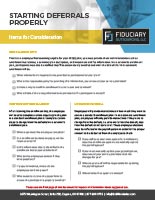
The Story
Sam’s Street Sweepers implemented automatic enrollment in 2012. At the time Helen, the payroll manager, was trained on how to pull the available on-line reports from Friendly Recordkeeper Services website. During the period of time Helen was employed, she pulled these reports prior to running each payroll.
About two months ago, Helen quit without giving notice. Helen’s boss, Brenda, filled in running payroll while a new payroll manager was hired. Brenda, in all the chaos, completely forgot about the automatic enrollment feature of the 401(k) plan. After 3 weeks, they hired Margaret to be the new payroll manager. Brenda didn’t train Margaret on the 401(k) plan automatic enrollment process so Margaret didn’t realize the plan was automatically enrolling participants. It was only when one of the participants asked a question and Margaret called Friendly to get the answer that she became aware that she was supposed to be automatically enrolling participants by downloading the change files each pay period.
How did they fix it?
Friendly Retirement Services did the research and determined that:
- as long as the affected participants were notified they would be automatically enrolled as soon as possible; and
- assuming the affected participants did actually start saving as soon as possible, no missed deferrals were due to affected participants; and
- since the plan doesn’t provide a match, no match was due to affected participants.
Margaret immediately issued the notice to the affected participants and coded the payroll system to reflect they would be deferring at the default rate for the next payroll. She also wrote up procedures for processing payroll so that her successor would know how to handle the 401(k) portion of running payroll each pay period.

The Mistake
Standard Enrollment Plans
Prior to an employee first becoming eligible for your 401(k) plan, you must provide them with information such as:
- how do they enroll in the plan
- a summary plan description
- if they can direct their own investments, plan investment options and performance data
- participant fee disclosure documents
The employee must then follow the plan’s outlined procedures to enroll and start saving.
From time to time, employers misplace the employee’s enrollment form or misread the website download if they use a website for enrollment. Perhaps an employee is rehired but no one realizes they were eligible to defer again on their rehire date rather than having to re-satisfy the plan’s entry requirements. In each of the cases, the employee missed the opportunity to save or saved an incorrect amount until the error is identified.
Automatic Enrollment Plans
Prior to an employee first becoming eligible for your 401(k) plan, you must provide them with information such as:
- notification they’ll be automatically enrolled if they take no action
- steps they must take to opt out of the plan or change their deferral election
- a summary plan description
- if they can direct their own investments, plan investment options and performance data
- participant fee disclosure documents
The employee must then follow the plan’s outlined procedures or they will commence saving on their entry date into the plan at the default rate.
From time to time, employers fail to realize someone is becoming eligible for the plan. Or, they fail to update the payroll system to reflect the default enrollments are commencing. In either case, employees fail to start saving when they should.

What Happens
The IRS has published extensive information on how to correct enrollment related salary deferral errors in Revenue Procedure 2013-12.
The exact amounts to be corrected and how to calculated them vary based on the following factors:
- Is the plan automatically enrolled or not?
- How long has the error been occurring?
- Does the plan provide for a discretionary or safe harbor or Qualified Automatic Contribution Arrangement (QACA) match?
Generally speaking, you’ll owe the employee a portion of the amount they would have deferred if the mistake hadn’t been made. If you make matching contributions, you’ll owe the employees some or all of the match they otherwise would have received if the mistake hadn’t happened. And, you’ll owe interest for the amount of time the money wasn’t in the plan.
Most of these errors can be self-corrected as soon as they are identified. You’d generally only have to submit to the IRS if the problem affected a significant portion of your population for a period of more than 2 years.
You’ll need the help of your service provider team or an outside consultant to determine how much is due and to whom.
Avoid it
Critical to enrolling employees timely is creating a process to ensure all of the necessary steps in the process are completed.
You must know:
- Who will identify employees who will shortly become eligible?
- Who will provide the necessary documentation to those employees?
- Who will track enrollments and provide reporting on how much each newly eligible participant should be set up to save?
- How will payroll be updated for this information?
If you allow employees to enroll via paper, you’ll need a process in place to ensure you save the paper elections. A best practice would be to require all employees to use the available on-line enrollment system or 800 number normally available through one of the plan’s service providers to record all enrollments. That way there is no question of whether a change was requested, when it was requested and who made the request.
If you can utilize a service provider team where the payroll system talks to the plan service provider offering the enrollment tracking, no manual intervention is necessary to update the payroll system for new enrollments. If instead you must manually update the enrollment data, make sure there is a written process and that the payroll person is aware of that process. It is not uncommon for us to see problems with enrollments when a new payroll person is hired to replace a payroll person who has left. The new person isn’t always trained on processing the 401(k) plan enrollments.

How We Help
Fiduciary Outsourcing can assist you to manage deferral elections in many ways.
You can authorize us to do any of the following based on your needs:
- Set up an email confirmation system to ensure your payroll department confirms each payroll period that they have downloaded the change files or gathered all the paper enrollment forms and made the necessary changes to the payroll system.
- Outsource to us downloading the changes file and making the changes in the payroll system.
- Verifying that all changes have been made each payroll period.

The Story
Sam’s Street Sweepers implemented automatic enrollment in 2012. At the time Helen, the payroll manager, was trained on how to pull the available on-line reports from Friendly Recordkeeper Services website. During the period of time Helen was employed, she pulled these reports prior to running each payroll.
About two months ago, Helen quit without giving notice. Helen’s boss, Brenda, filled in running payroll while a new payroll manager was hired. Brenda, in all the chaos, completely forgot about the automatic enrollment feature of the 401(k) plan. After 3 weeks, they hired Margaret to be the new payroll manager. Brenda didn’t train Margaret on the 401(k) plan automatic enrollment process so Margaret didn’t realize the plan was automatically enrolling participants. It was only when one of the participants asked a question and Margaret called Friendly to get the answer that she became aware that she was supposed to be automatically enrolling participants by downloading the change files each pay period.
How did they fix it?
Friendly Retirement Services did the research and determined that:
- as long as the affected participants were notified they would be automatically enrolled as soon as possible; and
- assuming the affected participants did actually start saving as soon as possible, no missed deferrals were due to affected participants; and
- since the plan doesn’t provide a match, no match was due to affected participants.
Margaret immediately issued the notice to the affected participants and coded the payroll system to reflect they would be deferring at the default rate for the next payroll. She also wrote up procedures for processing payroll so that her successor would know how to handle the 401(k) portion of running payroll each pay period.

The Mistake
Standard Enrollment Plans
Prior to an employee first becoming eligible for your 401(k) plan, you must provide them with information such as:
- how do they enroll in the plan
- a summary plan description
- if they can direct their own investments, plan investment options and performance data
- participant fee disclosure documents
The employee must then follow the plan’s outlined procedures to enroll and start saving.
From time to time, employers misplace the employee’s enrollment form or misread the website download if they use a website for enrollment. Perhaps an employee is rehired but no one realizes they were eligible to defer again on their rehire date rather than having to re-satisfy the plan’s entry requirements. In each of the cases, the employee missed the opportunity to save or saved an incorrect amount until the error is identified.
Automatic Enrollment Plans
Prior to an employee first becoming eligible for your 401(k) plan, you must provide them with information such as:
- notification they’ll be automatically enrolled if they take no action
- steps they must take to opt out of the plan or change their deferral election
- a summary plan description
- if they can direct their own investments, plan investment options and performance data
- participant fee disclosure documents
The employee must then follow the plan’s outlined procedures or they will commence saving on their entry date into the plan at the default rate.
From time to time, employers fail to realize someone is becoming eligible for the plan. Or, they fail to update the payroll system to reflect the default enrollments are commencing. In either case, employees fail to start saving when they should.

The IRS has published extensive information on how to correct enrollment related salary deferral errors in Revenue Procedure 2013-12.
The exact amounts to be corrected and how to calculated them vary based on the following factors:
- Is the plan automatically enrolled or not?
- How long has the error been occurring?
- Does the plan provide for a discretionary or safe harbor or Qualified Automatic Contribution Arrangement (QACA) match?
Generally speaking, you’ll owe the employee a portion of the amount they would have deferred if the mistake hadn’t been made. If you make matching contributions, you’ll owe the employees some or all of the match they otherwise would have received if the mistake hadn’t happened. And, you’ll owe interest for the amount of time the money wasn’t in the plan.
Most of these errors can be self-corrected as soon as they are identified. You’d generally only have to submit to the IRS if the problem affected a significant portion of your population for a period of more than 2 years.
You’ll need the help of your service provider team or an outside consultant to determine how much is due and to whom.
Avoid it
Critical to enrolling employees timely is creating a process to ensure all of the necessary steps in the process are completed.
You must know:
- Who will identify employees who will shortly become eligible?
- Who will provide the necessary documentation to those employees?
- Who will track enrollments and provide reporting on how much each newly eligible participant should be set up to save?
- How will payroll be updated for this information?
If you allow employees to enroll via paper, you’ll need a process in place to ensure you save the paper elections. A best practice would be to require all employees to use the available on-line enrollment system or 800 number normally available through one of the plan’s service providers to record all enrollments. That way there is no question of whether a change was requested, when it was requested and who made the request.
If you can utilize a service provider team where the payroll system talks to the plan service provider offering the enrollment tracking, no manual intervention is necessary to update the payroll system for new enrollments. If instead you must manually update the enrollment data, make sure there is a written process and that the payroll person is aware of that process. It is not uncommon for us to see problems with enrollments when a new payroll person is hired to replace a payroll person who has left. The new person isn’t always trained on processing the 401(k) plan enrollments.

How We Help
Fiduciary Outsourcing can assist you to manage deferral elections in many ways.
You can authorize us to do any of the following based on your needs:
- Set up an email confirmation system to ensure your payroll department confirms each payroll period that they have downloaded the change files or gathered all the paper enrollment forms and made the necessary changes to the payroll system.
- Outsource to us downloading the changes file and making the changes in the payroll system.
- Verifying that all changes have been made each payroll period.


